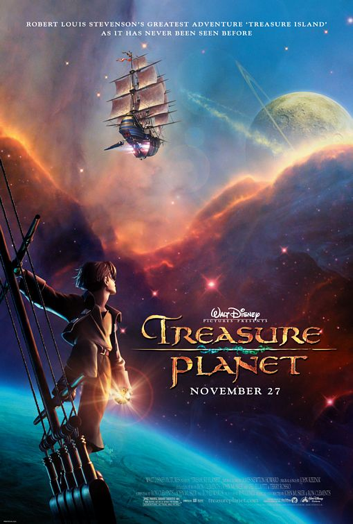Treasure Planet, an animated film produced by Walt Disney Pictures released on November 27, 2002. Dane A. Davis was the sound designer, sound editor and creator of Morph‘s (character) amazing voice.
Mix Magazine has an interesting article with the information about the sound process of Treasure Planet. Here is some info about sound design:
A major challenge was melding elements of the classic seagoing story with a large dose of futuristic action-adventure. “Throughout the project,” says Academy Award-winning sound designer Dane Davis (Danetracks owner, The Matrix, 8 Mile, Bound), “the directors maintained the concept of a 70/30 split — 70 percent familiar, traditional sounds and 30 percent exciting, fantasy-based sounds. We constantly strove for a balance between them to create an ‘antique future.’”
For example, pirate Long John Silver’s ship — a creaky, old Spanish galleon with masts, sails, rigging and rope — floats through space powered by solar sails that crackle and glisten with electrical energy as they absorb light to power the plasma rocket engines. “It creaks like a traditional tall ship when it turns or lists,” Davis says, “but it’s floating through a vast space ocean. It couldn’t sound like water, but it required the emotion and energy of wind and surf. Familiar and exotic at the same time.”
To create the sound for Silver, a cyborg with a mechanical prosthetic arm, Davis’ team scoured hobby shops and junk stores for antique windup toys and old spinning mechanisms. “We were able to manipulate those sounds to achieve the sophisticated end result we wanted,” adds Danetracks’ sound designer Rich Adrian, “but we purposely used unsophisticated sources to avoid sounding slick or sci-fi.”
Silver’s shape-shifting pet, Morph, got an even more organic treatment: “His molecules are constantly moving and rearranging,” Davis explains. “I used Jell-O in my hands to create movements, then digitally stretched and particalized the sounds to take it a bit out of our world. To integrate his movement and voice, we created vocal components using my voice through a mouthful of Jell-O.
Morph had to sound believable as an otherworldly creature, without coming across synthetic.”
For most of the other dialog, a traditional approach prevailed, with clarity being the goal. “We did some experimentation,” notes Porter, “especially with Ben the robot, a comic-relief character voiced by Martin Short. But everything we tried affected his comedy. Sometimes, when you start altering voices you lose emotion, and the last thing you want to do in a story like this is affect performances.
